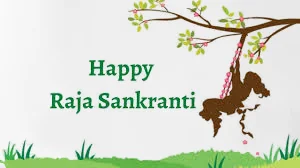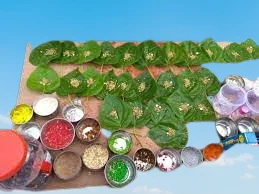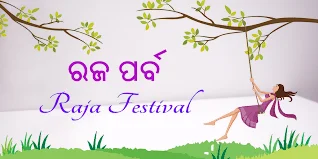Raja Sankranti: Raja Sankranti is a three-day long festival dedicated to girls and women/womenhood in Odisha, India. It is also called as Raja Parba or Mithuna Sankranti. Odisha is an eastern Indian state on the Bay of Bengal, is known for its tribal cultures and its many ancient Hindu temples. The capital city is Bhubaneswar. The second day of the festival signifies beginning of the solar month of Mithuna from, which the season of rains starts.
Raja Sankranti 2023
In 2023, Raja Sankranti will be celebrated from 14th June to 16th June. the first day is called Pahili Raja, second day is Mithuna Sankranti, third day is Bhudaaha or Basi Raja. The final fourth day is called Basumati snana, in which the ladies bath the grinding stone as a symbol of Bhumi ( Bhumi, also known as Bhudevi and Vasundhara, is a Hindu goddess who is the personification of the earth. She is a consort of the god Vishnu ) with turmeric paste and adore with flower, sindoor etc. All type of seasonal fruits are offered to mother Bhumi.

1st Day – Pahili Raja – 14th June’23, Wednesday
2nd Day – Raja Sankranti or Mithuna Sankranti – 15th June’23, Thursday
3rd Day – Basi Raja – 16th June’23, Friday
Raja Sankranti
The day before the 1st day, Pahili Raja is called as “Sajabaja”. This day is considered as a preparatory day for the next 3 days of Raja festival. Unmarried girls and women clean their houses, kitchen. They complete all the necessary works for the next three days as on these three Raja days ideally they do not work. They buy new clothes to wear for these 3 days. They wear new sarees, dresses, alata and ornaments on these three days.

They pass these three days in joyous festivity and observe customs like eating only uncooked and nourishing food especially Podapitha ( Poda pitha is slow-cooked pitha. It is made by slowly baking fermented rice, black gram, grated coconut and jaggery overnight. Its crust is slightly burnt, while the inside is soft and white. Poda pitha is generally made during Raja Parba ), do not take bath or take salt, do not walk barefoot and vow to give birth to healthy children in future.
Poda Pitha in Raja Sankranti
In Raja Sankranti, Poda Pitha is prepared from rice flour, is sweet in taste and dense in texture. Poda pitha is also offered to Lord Jagannatha.There are different types of Poda Pitha depending on the ingredients used to prepare it: Biri poda pitha, lau poda pitha, etc.
Poda pitha is prepared in a unique manner. A batter of rice and urad dal with coconut shreddings or grated coconut, jaggery, black pepper powder, ghee and salt is baked in an earthen vessel at night over a hearth. The vessel is covered with sal leaves or a banana leaf to let the pitha cook properly. In the morning of Raja, people enjoy this delicacy. The pitha is very aromatic and has the earthen flavour combined with the flavours of the ingredients used.
Along with Poda Pitha, people also enjoy Kakara, Manda Pitha, Chakuli Pitha, Arisha pitha, and Chandrakala. These native sweet food items are prepared with ingredients like rice, ghee, jaggery, black pepper powder and salt. What makes Odia sweets stand apart from others is the fact that it has a unique blend of sweet and spicy taste.
One of the main ingredients of Raja Sankranti delicacies is the native grown rice which is rich in nutrients. Healthy ingredients like jaggery, coconut and spices make Raja delicacies extremely healthy. The foods are prepared in earthen vessels, are slow cooked, have less use of oil and are easy to digest. Seasonal and local ingredients enrich Raja foods.
Every house prepare in advance for a rope swing to be hung from Banyan trees or from any tree where girls and women can enjoy these swings throughout the day singing lyrical traditional songs like . Another very special thing is consuming “Paan” ( Betel leaf with tasty ingredients or masalas ). On Raja, it is very common to see girls, women and everyone enjoys the Paan.

During the festival all agricultural operations remain suspended. As a mark of respect towards the Earth during her menstruation days, all agricultural works comes to a standstill during these days. Significantly, it is a festival of the unmarried girls, the potential mothers. They all observe the restrictions prescribed for a menstruating woman. The very first day, they rise before dawn, do their hair, anoint their bodies with turmeric paste and oil and then take the purificatory bath in a river or tank.
Peculiarly, bathing for the rest two days is prohibited. They don’t walk bare-foot do not scratch the earth, do not grind, do not tear anything apart, do not cut and do not cook. During all the three consecutive days, they are seen in the best of dresses and decorations, eating cakes and rich food at the houses of friends and relatives, spending long cheery hours, moving up and down on improvised swings, rending the village sky with their merry impromptu songs.
Raja Song Lyrics in Odia
ବନସ୍ତେ ଡାକିଲା ଗଜ
ବନସ୍ତେ ଡାକିଲା ଗଜ
ବରଷକେ ଥରେ ଆସିଛି ରଜ
ଆସିଛି ରଜଲୋ ଘେନି ନୁଆଁ ସଜ-ବାଜ
ବଉଳଲୋ ଘେନି ନୁଆଁ ସଜ-ବାଜ
ପାଚିଲା ପଣସ, ଆମ୍ବ
ପାଚିଲା ପଣସ, ଆମ୍ବ
ପରଖି ନକଲୁ ଯାହାଠି ଭାବ
ଯାହାଠି ଭାବଲୋ ସେତ ଦିନେ ଦଗାଦବ
ବଉଳଲୋ ସେତ ଦିନେ ଦଗାଦବ
ଥିରି-ଥିରି ଝୁଲା ଦୋଳି
ଥିରି-ଥିରି ଝୁଲା ଦୋଳି
ଓଢ଼ଣୀ ଯାଉଛି ପବନେ ଉଡ଼ି
ପବନେ ଉଡିଲୋ ଗଭାଫୁଲ ଯାଏ ଝଡ଼ି
ବଉଳଲୋ ଗଭାଫୁଲ ଯାଏ ଝଡ଼ି
ଉଠିଲା ବାଉଁଶ ଗଜା
ଉଠିଲା ବାଉଁଶ ଗଜା
ପରବ ଭିତରେ ରଜତ ରଜା
ରଜତ ରଜାଲୋ ଆସ ମନେଇବା ମଜା
ବଉଳଲୋ ଅସ ମନେଇବା ମଜା
ଆମ୍ବ ବନେ କେଳିକୁଞ୍ଜ
ଆମ୍ବ ବନେ କେଳିକୁଞ୍ଜ
Mobile ଆଣେ କେତେ message
କେତେ message ଲୋ ନୂଆ-ନୂଆ ଲାଗେ ରଜ
ବଉଳଲୋ ନୂଆ-ନୂଆ ଲାଗେ ରଜ
ଦୋଳି ଛୁଇଁଯାଏ ଡାଳ
ଦୋଳି ଛୁଇଁଯାଏ ଡାଳ
ପରଦେଶୀ ପ୍ରେମ ସାଜଇ କାଳ
ସାଜଇ କାଳଲୋ କାନ୍ଦି-କାନ୍ଦି ଯାଏ ବେଳ
ବଉଳଲୋ କାନ୍ଦି-କାନ୍ଦି ଯାଏ ବେଳ
ଦୋଳି ମୁଣ୍ଡ କଟ-ମଟ
ଦୋଳି ମୁଣ୍ଡ କଟ-ମଟ
ମୋ ଭାଇ ମୁଣ୍ଡରେ ସୁନା ମୁକୁଟ
ସୁନା ମୁକୁଟଲୋ ଦିଶୁଥାଏ ଝଟ-ଝଟ
ବଉଳଲୋ ଦିଶୁଥାଏ ଝଟ-ଝଟ
ପାଦରେ ଅଳତା ନାଲି
ପାଦରେ ଅଳତା ନାଲି
ଯିଏ ଖସିଦେଲା ଗଭାରେ ମଲ୍ଲି
ଗଭାରେ ମଲ୍ଲିଲୋ ତାକୁ ମୁଁ ପାରୁନି ଭୁଲି
ବଉଳଲୋ ତାକୁ ମୁଁ ପାରୁନି ଭୁଲି
ଏତ ଶେଷ ରଜ ମୋର
ଏତ ଶେଷ ରଜ ମୋର
ଆର ସନ ହବ ମୋ ବାହାଘର
ମୋ ବାହାଘରଲୋ ଭାଇ କିଣିଲେଣି ହାର
ବଉଳଲୋ ଭାଇ କିଣିଲେଣି ହାର
ଗୁମିହେଲା ରଜବତୀ
ଗୁମିହେଲା ରଜବତୀ
ମାଟିକି ହାଣିଲେ ଫାଟେତା ଛାତି
ଫାଟେତା ଛାତିଲୋ ସେତ ମା’ ବସୁମତୀ
ବଉଳଲୋ ସେତ ମା’ ବସୁମତୀ
ମାନୁଥିବୁ ରଜବିଧି
ମାନୁଥିବୁ ରଜବିଧି
ଚାଲିବୁ କଦଳୀ-ବାହୁଙ୍ଗା ବାନ୍ଧି
ବାହୁଙ୍ଗା ବାନ୍ଧିଲୋ ଗୁଆ ଖୋଳପାକୁ ପିନ୍ଧି
ବଉଳଲୋ ଗୁଆ ଖୋଳପାକୁ ପିନ୍ଧି
ଚହଟିଲା କୃଷ୍ଣଚୁଡ଼ା
ଚହଟିଲା କୃଷ୍ଣଚୁଡ଼ା
ରଜରେ ନଥାଏ ରନ୍ଧାକି ବଢ଼ା
ରନ୍ଧାକି ବଢ଼ାଲୋ ତିନିଦିନ ହାଣ୍ଡିଛଡ଼ା
ବଉଳଲୋ ତିନିଦିନ ହାଣ୍ଡିଛଡ଼ା
ଗୋଲାପ ଗଛର କଣ୍ଟା
ଗୋଲାପ ଗଛର କଣ୍ଟା
ଭାରି ଭଲଲାଗେ ଭିଣେଇ ଥଟ୍ଟା
ଭିଣେଇ ଥଟ୍ଟାଲୋ କରୁପଛେ ହଟ-ହଟା
ବଉଳଲୋ କରୁପଛେ ହଟ-ହଟା
Significance of Raja Sankranti
Raja Parba or Raja Sankranti is a three-day-long festival dedicated to Bhuma Devi, the Indian goddess who can be described as the Odia version of “Mother Earth.” The main aim of the festival is to honor Mother Bhuma as well as womanhood at large. The story behind the Raja festival is that the goddess of the Earth (Bhuma Devi), around whom much of the festival is centered, is said to undergo her menstrual cycle during this period (June). The word ‘Raja’ is the Odia word for ‘menstruation,’ derived from ‘Rajaswala,’ which is interpreted to mean ‘a menstruating woman.’

Raja Parba is a festival that celebrates the peculiarity of menstruation as an aspect of womanhood. Menstruation is considered a sign of fertility, and so Raja celebrates femininity and the ability of women to give birth to another life. During the Raja Parba, Odia people lay off all construction works or other activities which involve digging up the earth. It is believed that in doing this, they pay homage and respect to Mother Earth.
Raja Sankranti signifies the beginning of the solar month of Mithuna, from which the season of rains starts. According to religious beliefs, it is believed that the mother Goddess Earth (the divine wife of Lord Vishnu) undergoes menstruation during the first three days.
Some wishes in Raja Sankranti
- Enjoy the Raja festival, which celebrates womanhood! I hope this festival brings you happiness and prosperity. Happy Raja!
- It is my wish that the aroma of Poda Pitha fills your life with happiness during this Raja festival. Enjoy your Raja festival.
- Enjoy the Raja Doli with endless excitement and fun. A very Happy Raja to you.
- A very happy Raja to you. May Lord Jagannath bless you forever.
- Enjoy mouth-watering poda pitha, chakuli, and other Odia delicacies at this year’s Raja celebration. Enjoy the festival!
- When you wear new clothes, have alata on your feet, kumkum on your forehead, and mehndi on your hands, you look the most beautiful. Happy Raja!
- We hope that Raja Paan makes this festival and your life sweeter. Have a wonderful Raja!
Hope you liked this article about Raja Sankranti by read4knowledge. Like, follow and share for more interesting articles.